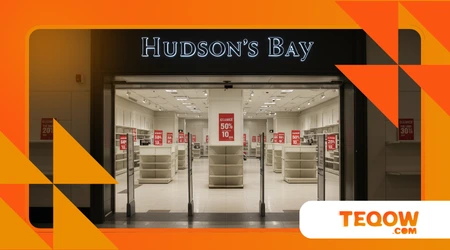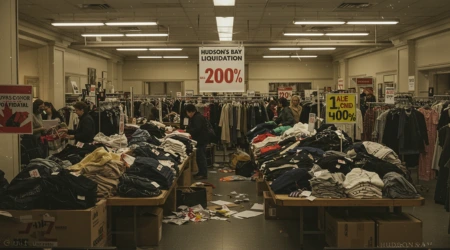Hudson’s Bay Begins Liquidation: The End of a Canadian Retail Icon

Hudson’s Bay Begins Liquidation of its final six stores across Canada on April 25, 2025, a moment that feels like the closing chapter of a storied novel.
The Hudson’s Bay Company (HBC), founded in 1670 as a fur-trading enterprise, has been a pillar of Canadian identity for over three centuries, evolving into a department store chain beloved for its quality and heritage.
The liquidation of flagship locations in Toronto’s Yonge Street, Yorkdale, and Hillcrest Mall, alongside Montreal’s downtown, Carrefour Laval, and Pointe-Claire stores, marks the end of HBC’s retail presence.
This isn’t just a business failure—it’s a cultural loss, akin to a lighthouse going dark on a stormy coast.
This article dives deep into the causes, consequences, and future implications of HBC’s collapse, blending human stories with hard facts to paint a vivid picture of a nation at a retail crossroads.
Why does this matter, and what can Canada learn from it? Let’s explore.
The Financial Collapse Driving Liquidation
The decision to liquidate stems from a financial quagmire too deep to escape.
Court filings from Reflect Advisors, HBC’s financial consultant, reveal debts nearing $1 billion, with a “low probability” of finding buyers for the six stores.
Hudson’s Bay Begins Liquidation after court approval to close 90 of 96 stores by mid-June failed to yield a restructuring path.
The remaining six were a last-ditch hope, but no viable bids materialized, as Adam Zalev of Reflect Advisors noted in an affidavit.
HBC’s debt woes trace back to its 2013 acquisition of Saks Fifth Avenue, a $2.9 billion deal that strained its finances.
High interest rates and inflation in 2025 exacerbated the issue, while e-commerce giants like Amazon outpaced HBC’s sluggish online pivot.
Imagine a marathon runner carrying a backpack of bricks—HBC couldn’t keep up.
The liquidation process itself is a race against time. Discounts of 15-40% have sparked frenzied shopping, but court documents warn that unsold inventory risks being sold at a loss.
The Toronto Star reported that HBC’s Etobicoke warehouse sale, running through April 2025, is a microcosm of this chaos, with shoppers hunting deals as shelves empty.
+ Ontario’s Electric Vehicle Supply Chain Gets a Boost
The Human Cost of Closure
The toll on employees is heart-wrenching. Over 9,000 workers face job losses, with 200 corporate staff already terminated without severance, per The Toronto Star.
Consider Sarah, a fictional cosmetician at Yonge Street’s store, who after 15 years learned her commission pay was slashed, threatening her family’s stability. Her story mirrors thousands.
Unifor, representing Ontario beauty advisors, has filed grievances, arguing HBC’s commission cuts breach contracts.
“This is a company abandoning its people,” said Unifor’s Samia Hashi. The lack of severance for many underscores a grim reality: loyalty means little in corporate collapse.
For Michael, a fictional Toronto warehouse worker, the liquidation is a personal blow. After a decade at HBC, he faces unemployment with no safety net.
The Globe and Mail noted HBC’s vague “hardship fund” for struggling workers, but without details, it’s a hollow promise, leaving employees adrift.
+ New Rules for International Students: What’s Changing in 2025?
Community and Economic Ripples
HBC’s stores were more than retail—they were community anchors. The Yonge Street flagship, a Toronto landmark, drew locals and tourists alike.
Its closure leaves downtown Toronto quieter, like a town square losing its heartbeat. Montreal’s Carrefour Laval store, a mall cornerstone, faces similar loss.
A 2025 Retail Council of Canada report estimates department store closures could cut mall foot traffic by 15% in affected areas.
Smaller retailers, reliant on HBC’s draw, now face survival challenges. In Pointe-Claire, local café owner Marie, a fictional character, worries her business will suffer without HBC’s foot traffic.
Suppliers are also hit hard. The Globe and Mail reported unpaid invoices piling up, with some vendors facing losses in the millions.
This domino effect threatens local economies, as malls struggle to fill vacant HBC spaces, potentially turning vibrant hubs into ghost towns.
| Store Location | City | Region | Status |
|---|---|---|---|
| Yonge Street | Toronto | Ontario | Liquidation |
| Yorkdale Mall | Toronto | Ontario | Liquidation |
| Hillcrest Mall | Richmond Hill | Ontario | Liquidation |
| Downtown Montreal | Montreal | Quebec | Liquidation |
| Carrefour Laval | Laval | Quebec | Liquidation |
| Pointe-Claire | Pointe-Claire | Quebec | Liquidation |
A Cultural Legacy at Risk
HBC’s iconic stripes—green, red, and white—are a Canadian emblem, adorning blankets and mugs.
Hudson’s Bay Begins Liquidation has sparked a surge in striped merchandise sales, per a BBC report, as shoppers cling to nostalgia. Yet, this feels like a farewell, not a revival.
The 1670 royal charter, granting HBC trading rights over Indigenous lands, is a historical artifact at risk.
The Canada Advisory Committee for Memory of the World urges its transfer to public archives, like the Archives of Manitoba, to prevent private sale.
Losing it would be like auctioning a piece of Canada’s soul.
Weihong Liu, a Chinese billionaire, expressed interest in April 2025 via social media to buy HBC stores and preserve their legacy.
Her plan, though inspiring, lacks a firm offer, leaving archivists and historians anxious about HBC’s cultural artifacts slipping away.
The Retail Landscape’s New Reality
HBC’s collapse reflects a broader retail reckoning. Sears and Zellers are gone, and HBC’s exit accelerates this trend.
The Retail Council of Canada notes e-commerce now accounts for 14% of retail sales in 2025, up from 8% in 2020. HBC’s pop-up shops and online expansions couldn’t compete.
Smaller retailers might seize this moment. Picture a local boutique in Toronto’s Yorkdale Mall, fictional “Maple Threads,” launching an online store to capture HBC’s former customers.
Such innovation could reshape retail, but it requires agility HBC lacked.
The loss of Saks Fifth Avenue’s Montreal store, part of the liquidation, dims Canada’s luxury retail scene.
Hudson’s Bay Begins Liquidation thus signals a shift: Canada’s retail future may lie in niche, digital-first brands, not sprawling department stores.
Can HBC’s Legacy Inspire a Revival?
A faint hope persists. Court documents allow HBC to halt liquidation if a bid emerges before June 15.
Four parties, per The Globe and Mail, have shown interest in HBC’s assets, including its charter. But interest isn’t action, and time is short.
The liquidation frenzy—discounts drawing crowds—highlights HBC’s enduring appeal. Yet, each sale chips away at its existence, a paradox where survival hastens demise.
Could a visionary investor reimagine HBC for the digital age, or is this truly the end?
Canada’s retail sector must adapt. Hudson’s Bay Begins Liquidation is a wake-up call for malls to diversify tenants and for retailers to embrace e-commerce.
The question looms: Will Canada’s next retail giant rise from these ashes, or are we witnessing a permanent shift?
Conclusion: A Nation Reflects and Rebuilds
As Hudson’s Bay Begins Liquidation, Canada mourns more than a store—it mourns a piece of its identity.
The final six stores, once symbols of resilience, now face empty shelves and locked doors. HBC’s 355-year journey, from fur trading to retail dominance, shaped a nation’s economic and cultural fabric.
Its failure to evolve mirrors the fate of many legacy brands, a cautionary tale for retailers clinging to nostalgia.
Yet, in this loss lies opportunity. New retailers, perhaps leaner and digitally savvy, could redefine Canada’s retail landscape.
The challenge is clear: innovate or fade. As we bid farewell to HBC, we must ask what comes next for a nation built on commerce and community.
The answer will shape Canada’s future, one store, one story, at a time.
Frequently Asked Questions
Why is Hudson’s Bay closing its final stores?
HBC is liquidating due to $962 million in debt, failed restructuring, and no viable buyers, as per court filings.
Which stores are affected?
The six stores are in Toronto (Yonge Street, Yorkdale, Hillcrest), Montreal (downtown, Carrefour Laval, Pointe-Claire).
What happens to employees?
Over 9,000 workers face job losses, with some corporate staff terminated without severance, though a hardship fund is proposed.
Can the liquidation be stopped?
A viable bid before June 15 could halt liquidation, but no firm offers have emerged.
What’s next for HBC’s legacy?
Artifacts like the 1670 charter may go to public archives, while striped merchandise sees a nostalgic sales surge.

